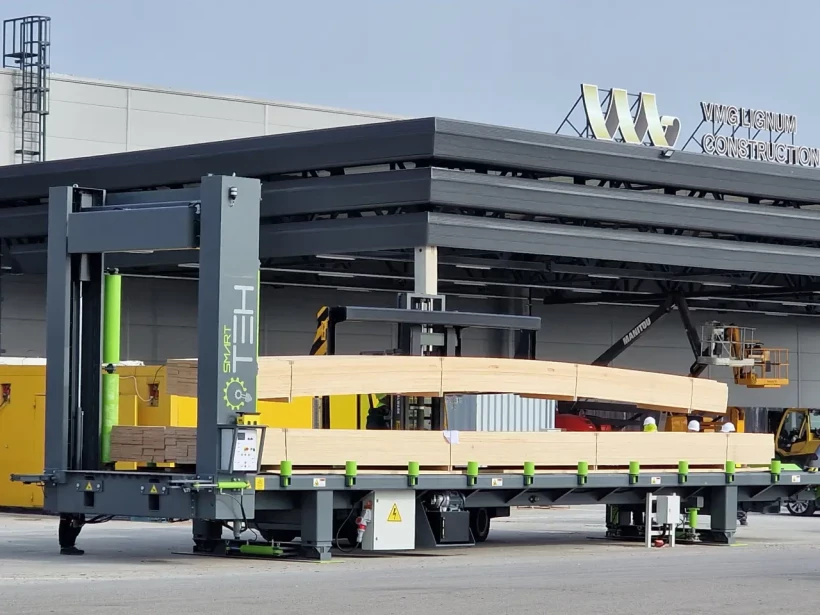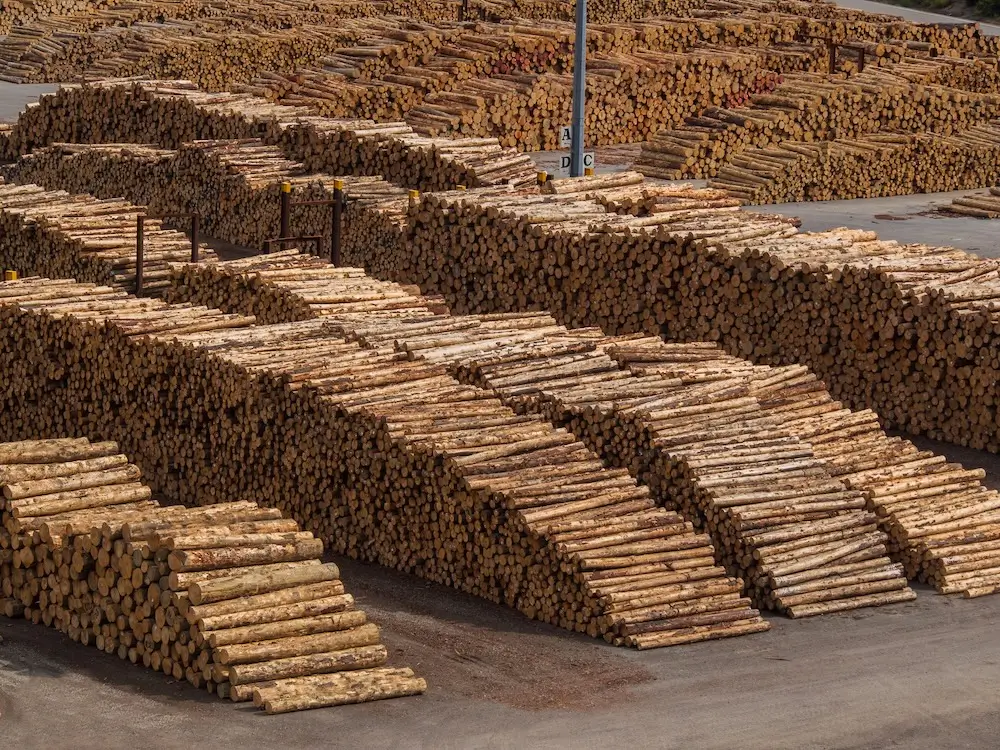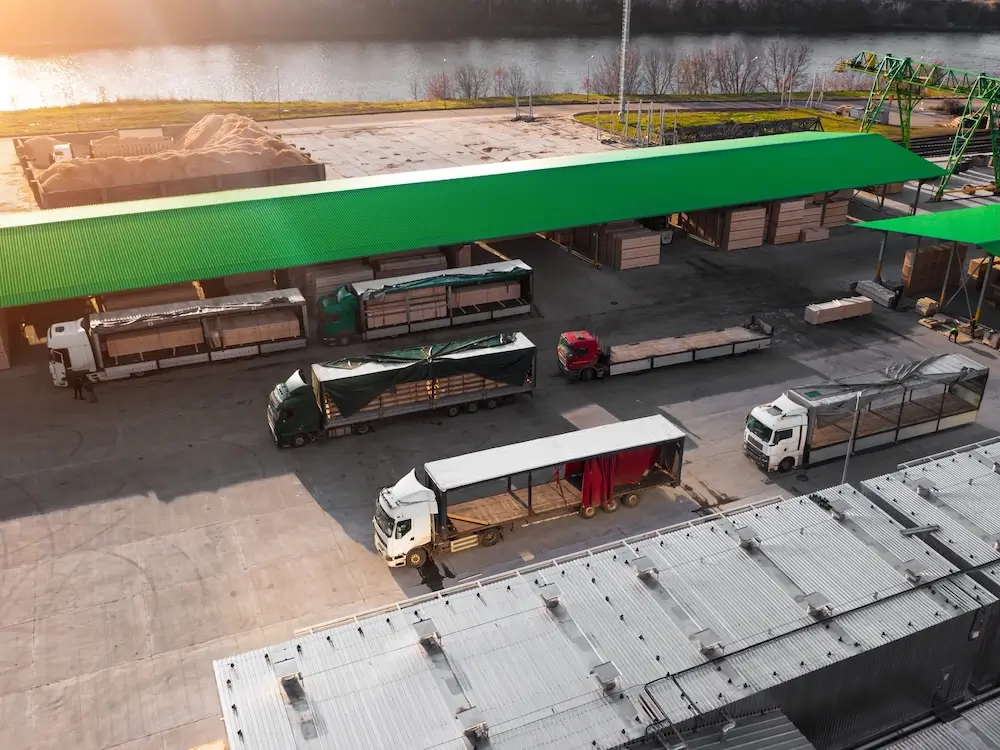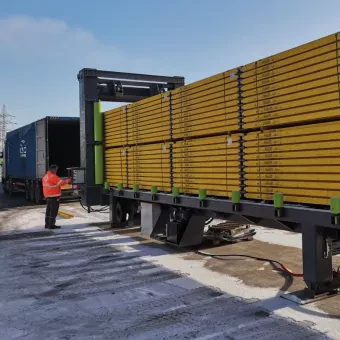
The wood industry is on a growth streak, and it’s showing no signs of slowing down. It’s estimated that the global wood and timber products market size will grow from approximately $992 billion in 2024 to $1.251 billion in 2030.
As demand for lumber and wood products soars across construction materials, furniture, and packaging, lumber freight shipping volumes are skyrocketing worldwide. But with growth comes a challenge: rising logistics costs.
For suppliers and distributors, finding smarter, more efficient ways of shipping lumber isn’t just good business. It’s essential for staying competitive.
Read on to discover the main factors that affect lumber shipping costs – and practical ways to save money.
- Maximize load and transport efficiency: Prioritize full-truckload (FTL) shipments and choose cost-effective transport like maritime or rail for long distances.
- Strategic location is key: Close proximity to raw materials and key markets cuts fuel, labor, and overall shipping costs.
- Invest in automated equipment: Automation at the loading dock speeds up handling, reduces product damage, and improves space utilization.
- Manage energy smartly: Reduce waste with fuel-efficient fleets, energy-saving sawmill machinery, and high-efficiency drying kilns.
- Use digital tools and coordinate: Real-time tracking, optimal load planning, and strong partnerships with carriers cut expenses and improve supply chain efficiency.
How wood type and quality impact lumber shipping costs
Species and growth rate
Different types of wood come with different price tags. Slow-growing species take longer to harvest, which makes them more expensive. Faster-growing trees, on the other hand, are usually cheaper to produce and easier to source.
Board size and dimensions
Size also makes a difference. Larger and longer dimensional lumber is harder to find, which drives up the cost. Smaller boards are typically more affordable and widely available.
Seasonal price changes
Wood prices often fluctuate with the seasons. During heavy rains or freezing winters, harvesting and lumber transportation services get trickier, pushing prices up.
The cost (and benefit) of drying
Drying treated lumber adds an extra step – and some extra cost – but it’s well worth it. When moisture levels drop below 20%, the wood becomes more durable and resistant to rot and fungi. Plus, it keeps its shape, color, and strength – all signs of quality your customers will notice.

How location shapes your lumber logistics
In the wood industry, lumber transport can get complicated fast. Production sites are often far from major industrial hubs or end customers – and that distance directly affects lumber shipping costs.
Where your factory or sawmill is located plays a huge role in how much you’ll spend on lumber shipping services. The farther and more difficult it is to reach your production center or target market, the higher your costs climb.
Several factors influence this:
- Total distance to production sites and markets: the longer the haul, the higher the fuel and labor expenses.
- Road and terrain conditions: rough, hilly, or muddy terrain slows lumber hauling and adds wear on vehicles.
- Geography and weather: heavy rain, snow, or high soil humidity can make access difficult and unpredictable.
- Transportation routes: whether you’re transporting lumber by river, rail, sea, or road, each route type has different costs and limitations.
Choosing a strategically located factory – close to both raw materials and key markets – can significantly reduce logistics expenses and streamline your entire supply chain.
Choose efficient lumber transportation
When it comes to shipping wood, your choice of shipping method can make a big difference in both cost and control.
Own fleet vs. outsourcing
If you have your own truck fleet, you’ll have more control over lumber hauling costs, delivery schedules, and service quality. Outsourcing lumber shipping services can simplify logistics, but it usually means giving up some control – especially over wood shipment delivery speed and customer experience.
Pick the most efficient transport equipment
For international or long-distance lumber shipment, it pays to compare your options.
Maritime and rail transport are often the most cost-effective solutions for bulk shipments. Truck transport with standard flatbed trucks is flexible, but tends to get expensive over long distances.
In large countries like the U.S., Australia, or Brazil, using road trains can help reduce those costs by moving more cargo per trip.
Maximize your load efficiency
The same applies to containers: one full order per container is more efficient than multiple smaller shipments. Combining partial shipments means more handling, longer routes, and higher costs due to multiple stops. Keeping loads consolidated saves both time and money.

Cut costs with a smart energy management plan
Energy is one of the biggest (and most overlooked) expenses when transporting lumber. From powering sawmills to running heavy machinery and drying wood, energy use adds up fast.
A clear energy management plan can help reduce operational costs while also improving sustainability.
What energy management really means
At its core, energy management is about taking control of how your business consumes energy – measuring, optimizing, and reducing waste at every stage of production and transport.
The lumber sector relies on a mix of energy sources, including electricity, diesel, gasoline, and thermal energy used in the drying process. Managing these efficiently can translate to significant long-term savings.
Where to find energy saving opportunities
- Harvesting: Upgrade to modern, fuel-efficient harvesters and chainsaws.
- Fleet operations: Maintain vehicles regularly and ensure tires are properly inflated to cut fuel waste.
- Sawmill operations: Use energy-efficient motors, variable speed drives, and smart sensors to reduce idle time.
- Drying: Switch to high-efficiency kilns, improve insulation, and reuse waste heat where possible.
An energy management plan isn’t a one-time fix – it’s an ongoing process. Track your energy use, set reduction goals, and review performance. Even small improvements can lead to big cost reductions over time.
Optimize lumber shipment packaging and handling
Even though lumber seems sturdy, packaging and handling still play a big role in shipping costs – especially when exporting. Poor stacking or inadequate protection can cause breakage, warping, or moisture damage, which adds hidden expenses.
Tips to cut costs through smarter packaging:
- Use standardized pallet sizes to make stacking and loading more efficient.
- Wrap lumber with recyclable, moisture-resistant packaging materials instead of heavy-duty plastics.
- Train workers on proper strapping and stacking techniques to reduce product loss and handling time.
Small improvements in packaging ensure safe delivery, minimize damage claims, and reduce rework – all contributing to lower overall costs and a smooth shipping experience.

Embrace automation and digital tracking
Technology is reshaping logistics, and lumber hauling is no exception. From inventory management to real-time tracking, automation helps reduce manual work and improve accuracy.
Where digital tools can make an impact:
- Inventory management: Use barcode or RFID systems to track stock in real time and avoid costly overproduction.
- Load planning: Software can determine optimal stacking configurations, preventing space waste and damage during lumber transport.
- Fleet management: Telematics and GPS tracking monitor routes, driver performance, and fuel use – helping identify inefficiencies before they become costly.
- Predictive analytics: Use data to forecast demand and plan shipments proactively, reducing idle inventory and unnecessary transport.
Digital solutions provide valuable data to help you forecast demand, prevent overproduction, and make smarter operational decisions.
The benefits of automation don’t stop at data or planning. They extend to physical operations, too – especially loading and unloading.
Use the right machinery for efficient wood loading
When it comes to transporting lumber and wood, using the right loading equipment can make all the difference in cost, speed, and safety.
Traditional forklifts often aren’t up to the task. They have weight and maneuverability limits, and they’re usually busy with other warehouse jobs, which can delay loading and unloading. Cranes, while powerful, aren’t designed for handling bulky lumber efficiently, often slowing down operations even more.
Trucking companies rarely carry their own loading equipment, and drivers may not be responsible for loading or unloading heavy cargo. This often leads to wasted time, extra labor costs, and potential product damage.
To handle heavy, long, or awkward loads like lumber, many businesses are switching to automated loading systems designed specifically for the wood industry. These machines not only speed up the process but also improve safety, precision, and space utilization.
Container Loading System
A Container Loading System is built to handle bulky, heavy goods quickly and safely. It uses a sliding floor mechanism to load entire stacks of lumber directly into truck trailers and shipping containers in one smooth movement – no need for ramps or multiple forklifts.
This approach is especially valuable for high-volume exporters who need consistency and speed. The system helps with:
- Shorter loading and unloading times (minutes instead of hours)
- Lower labor and lumber transport costs by reducing manual handling
- Reduced product damage thanks to stable, controlled loading
- Better use of cargo space, ensuring optimal weight distribution
Many sawmills integrate these systems into existing workflows, making it easy to automate the final step of production. This creates a seamless flow from sawmill to shipment and helps maintain a steady loading schedule.
Log Loader
A Log Loader is ideal for handling logs and other heavy, elongated goods that are difficult to load with forklifts or cranes. It combines a moving loading tub and adjustable sidewalls for different log sizes.
The result is faster, safer, and more precise loading – with less risk of shifting or uneven weight distribution during transport.
Advantages include:
- Fast, accurate loading into containers
- Adaptable sidewall design for various log dimensions
- Built-in weighing systems for load precision and compliance
- Low maintenance and operational costs over time
Because these systems minimize manual handling, they also reduce the risk of worker injury and product damage – two hidden costs that often go unnoticed in lumber transport.
Choosing the right specialized equipment isn’t just about convenience. It’s about cutting costs, improving efficiency, and ensuring your lumber shipments are handled properly and delivered safely. Investing in the right machinery helps keep your operations efficient, reliable, and ready to scale.
Improve supply chain coordination
In lumber logistics, even small communication gaps can lead to major delays or extra costs – especially when multiple suppliers, transporters, and customers are involved.
Improving coordination across the entire process helps minimize idle time, avoid shipment overlaps, and optimize load consolidation.
Practical tips:
- Share forecasts and schedules: Keep your suppliers and transport partners updated on demand changes and delivery windows.
- Use centralized logistics software: Platforms that integrate production, inventory, and shipping schedules help prevent bottlenecks and missed opportunities for load sharing.
- Build long-term partnerships: Working consistently with trusted partners can reduce rates, improve reliability, and simplify documentation and customs processes.
Good coordination doesn’t just lower costs. It keeps your operations predictable and your customers satisfied.
Optimize lumber export and customs processes
For exporters, customs delays and compliance errors can quickly eat into profits. Lumber and wood products often face strict export regulations, especially regarding species origin, treatment, and sustainability certifications.
How to stay efficient and compliant:
- Standardize documentation: Keep all essential paperwork (invoices, packing lists, phytosanitary certificates) organized and digitized.
- Verify regulations early: Check import/export requirements for each destination country, especially if you’re dealing with protected species or treated wood.
- Partner with experienced and reputable carriers: They can help you navigate customs efficiently and avoid unnecessary storage or demurrage fees.
Being proactive about customs and compliance ensures your shipments move smoothly across borders – without surprise costs or legal risks.
Towards more cost-effective lumber freight shipping
The cost of hauling lumber and wood depends on many moving parts – from material choices and energy use to transport routes and loading equipment. While not every factor is within your control, optimizing what you can makes a significant difference. Small changes, like improving load efficiency, introducing automation, or upgrading machinery, can add up to major savings over time.
Ultimately, reducing logistics costs isn’t just about spending less – it’s about building smarter, more resilient operations. As the global demand for wood continues to rise, companies that invest in efficiency, sustainability, and innovation today will be the ones leading the industry tomorrow.





